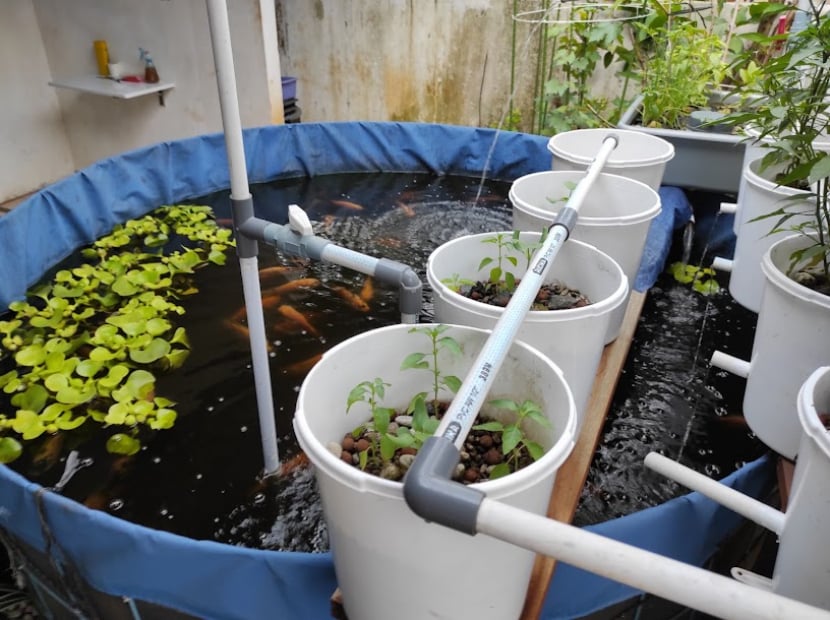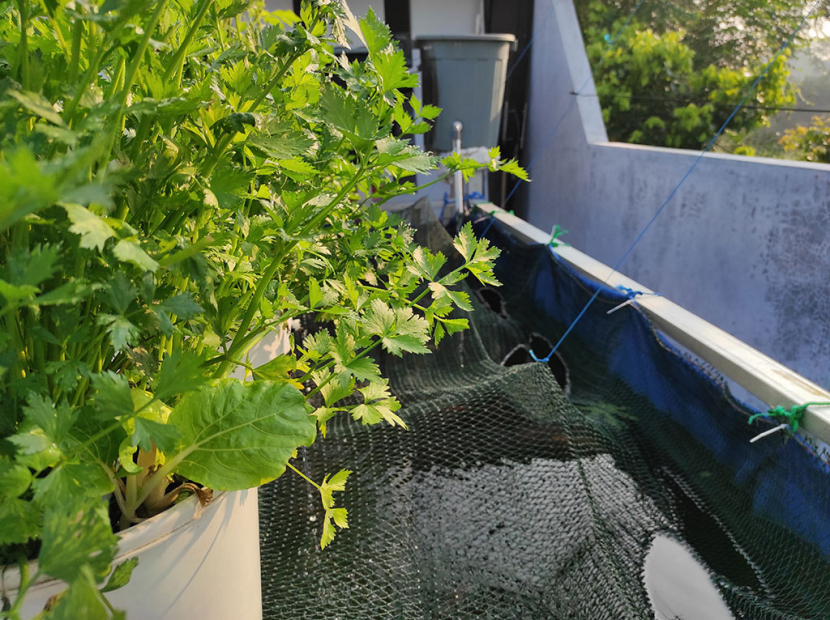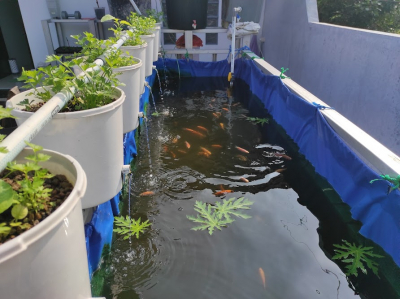Friend Signal lover organic agriculture Of course, you are already familiar with the term Aquaponics. Say Aquaponics itself is an abbreviation of Aquaculture and Hydroponics. Aquaculture or aquaculture refers to the cultivation of animals and plants using the main component of water. While hydroponics refers to modern agriculture which also uses water as its main component.
In short, with this aquaponics system, you can raise fish while growing vegetables and even fruits. You don’t need to think about what fertilizers for the growth of your vegetables, and you don’t need to do watering every day.
Vegetables will get nutrients from sewage and fish feed that are processed by the system. And vice versa, fish will get a supply of nutrients and oxygen that is absorbed by plant roots. So, mutually beneficial to each other. Fish are healthy and big fast, vegetables also grow healthy and harvest fast.
Scroll to read
Scroll to read
<!– – –>
<!–
In the Aquaponics System, pond water will be rotated from the pond to the plants. Then from the plants back to the pond. This system is called RAS ( Resirculation Aquaculture System) by adding a filter bucket to purify the water and add good bacteria. In this way, the water remains clear and will certainly save a lot of water.
Well, my friend must be interested in this Aquaponic system, especially the way it is made is also easy and quite simple. You can adjust the capital for making it according to the available funds and the goals that you will achieve.
The Signal team has tried this Aquaponic system themselves and has succeeded in cultivating red tilapia, cork and carp. The pool is made of tarpaulin with a light steel frame with a pool size of 3m x 1m x 0.75m.
About 200 fish seeds were stocked with 3 different types of fish, namely red tilapia, carp and cork. The initial seed size is about 4-5cm. The pool is placed on the 2nd floor and is left open without shade so that the sun can enter all day long.
Well, if you want to emulate the system we made, let’s see what needs to be prepared.

Aquaponic System Needs
1. Pool
2. Ember Filter
3. Filter material (ziolite stone, coconut fiber, foam, fishing net, bioball, ceramic ring, etc.)
3. Submersible Fish Pond Pump 1.5m height ( Yamano 103)
4. Paralon pipe and its supports
5. Plant pot
Preparations Before Stocking Fish Seeds in the Pond
1. Tarpaulin pool or Cement Pool
Buddy can use any size tarpaulin pool, adjust to the available funds. If the open space is large enough, you can use a round tarp pool with a diameter of 2m or 3m. Or a tarpaulin pool measuring 3mx1mx1m is also okay. The point is just adjust to your needs.
We use a 3m x1m x0.75m long tarpaulin using an Orchid brand semi-rubber tarpaulin to make it stronger, the price is around 300 thousand. Frame using mild steel, approximately the cost of 700 – 900 thousand.
Before filling the fish, there are several treatments that must be done so that the pond water is ready to use. Fill the pool with ordinary well water, if it is not available, it is okay to use PAM water but it needs to be left on longer. Enter the fishery EM4 (10 to 20 ml) into the pond but first dissolve it in a dipper, stir until blended before spreading it into the pond.
EM4 ( Effective Microorganism ) serves to increase the bacteria that decompose organic matter, suppress the growth of pathogenic bacteria, stimulate digestive enzymes and improve water quality in pond land.
If you have PSB type POC (photosynthetic bacteria) or Eko Enzym fluid, add it to the pond. The dose is the same about 10-20 ML. The addition of this liquid will enrich the variety of good bacteria that will nourish the pool water. You can also add krosok salt water to taste.
Leave it for about 1 week, to make sure the water is filled with good bacteria that will make the fish comfortable in the pond. Every day try to stir the pool water so that there is oxygen that will turn on the bacteria. After 1 week or so, fish seeds can be stocked into the pond.
If you use a cement pond and it’s new, it’s best to leave it for a bit longer to make sure there’s no cement smell that could harm the fish’s life.
2. Filter Preparation
The function of the filter in addition to purifying the water, also serves as a home for bacteria. Nitrosomonas sp is a bacterium that is in charge of converting Ammonia into nitrite content, then Nitrobacter sp is in charge of converting nitrite content into nitrate which helps for the process of plant fertilization.
In our test, the filter is divided into 3 buckets with their respective functions as follows:
– Bucket 1 serves to settle the pool water. Not filled with anything just allowed dirty water to settle at the bottom of the bucket. The clean water goes to the 2nd bucket
– Bucket 2 functions as a mechanical filter, consisting of fishing nets, foam, coconut fiber, ziolite stone
-Ember 3 functions as a biological filter, consisting of a bioball, ceramic ring or you can use other simple biological filters such as mineral water caps. The point is that in this filter, bacteria are made comfortable so they feel at home living in their homes. Better yet, given additional oxygen by adding an aerator to the 3rd bucket.
3. Preparation of Plant Seeds
Prepare plants by planting seeds first, you can use rockwool like if you make hydroponic preparation seeds. Seeds can also be grown through soil media and spread in the hatchery.
After the plant has 3-4 leaves, the seeds are ready to be transferred to the aquaponics container
4. Preparation of Fish Seeds
Fish seeds can be purchased at the nearest nursery. We recommend that you look for a location that is not too far away so that the fish stay healthy and not stressed on the way of delivery. If you buy seeds online, make sure the seller is trustworthy and look for the one closest to your home location.
Fish seeds should be 7-9 cm or larger in order to adapt quickly, but if you want to be more efficient, you can use 4-5 cm seeds. However, small seeds are prone to death, especially if the pond water is not well prepared.
Fish mortality rates can be tolerated up to 10 percent. If the death rate is more than that, it means that the pool water content must be re-checked.
5. Planting Media and Plant Pots
Plant pots using an 8 liter ice cream bucket. The planting media uses pumice and poor sand. The bottom of the pot is perforated for water channels to return to the pool.
Above the plant pot is connected a 3/4 inch paralon pipe with a hole in the middle so that water can come out. This water is for watering the plants.

Aquaponic Care
Aquaponics in trials using the RAS system. So that the flowing water will continue to rotate through the filter before entering the pool. The treatment is to check the pool filter in bucket 1 to bucket 3. If in bucket 1 the water is too dirty, remove the water by opening the faucet at the bottom of the bucket. Likewise with the other buckets.
Check the condition of the fish. If the appetite is big and nothing floats like running out of oxygen, the fish are healthy. Once a month or see the condition of the pool, spread it evenly into the EM4 liquid pool size 1 bottle cap of mineral water by stirring first in a water scoop
If the RAS Aquaponics system runs well, the plants will thrive with a harvest period of around 20 DAP (days after planting). Harvest tilapia about 4-5 months, carp and cork 8-12 months, catfish about 2-3 months.
good luck
-“).attr({
type: ‘text/javascript’,
src: ‘https://platform.twitter.com/widgets.js’
}).prependTo(“head”);
if ($(“.instagram-media”).length > 0)
$(”


